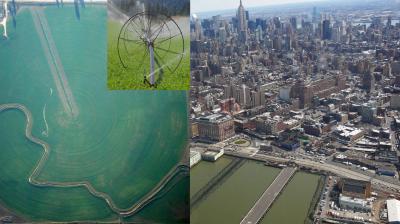Contrasting How Urbanization and Irrigation Affect Mid-Atlantic Summer Precipitation
Urbanization and irrigation can significantly influence rainfall, but how these effects vary among different rain types is unclear. Researchers investigated how large-scale urbanization and irrigation in the United States affected the three dominant types of summer precipitation in the mid-Atlantic region: mesoscale convective system (MCS), isolated deep convection (IDC), and non-convective (NC) precipitation. They found that urbanization suppresses all three types of precipitation, while irrigation enhances NC and IDC precipitation. Irrigation has contrasting influences on the mid-Atlantic precipitation produced by MCSs initiated locally and remotely through changes in the large-scale atmospheric circulations.
The contrasting influences of large-scale irrigation on locally and remotely initiated MCS precipitation highlight the complicating role atmospheric circulations can play on how land use and land cover changes affect precipitation. This study also highlights the importance of understanding the diverse effects of human activities on precipitation. For regions, such as the mid-Atlantic, where many rain types contribute to summer rainfall changes in both the total rain amount and the contributions of different rain types have implications for water resources and their management.
Researchers conducted convection-permitting regional model simulations with and without urbanization or irrigation. They used the simulations to investigate how large-scale urbanization and irrigation in the United States east of the Rocky Mountains affect summer precipitation in the highly populated mid-Atlantic region. They applied a feature tracking algorithm to classify three types of precipitation (MCS, IDC, and NC) and examined the effects of large-scale urbanization and irrigation on each rain type.
The researchers found that urbanization suppresses all three types of precipitation in the mid-Atlantic region by reducing water vapor and atmospheric instability. In contrast, irrigation enhances IDC, NC, and locally initiated MCS precipitation. The irrigation also suppresses rainfall produced by MCSs initiated in the Great Plains and Midwest, producing conflicting effects on MCS precipitation. The surface cooling due to irrigation induces a high-pressure anomaly at sea level, which is compensated by a mid-level low-pressure anomaly. The mid-level pressure anomaly then weakens the prevailing mid-level westerly wind over the Midwest and the mid-Atlantic region, which hinders the eastward movement of MCSs toward the mid-Atlantic region.
This work employed computational resources from the National Energy Research Scientific Computing Center.

